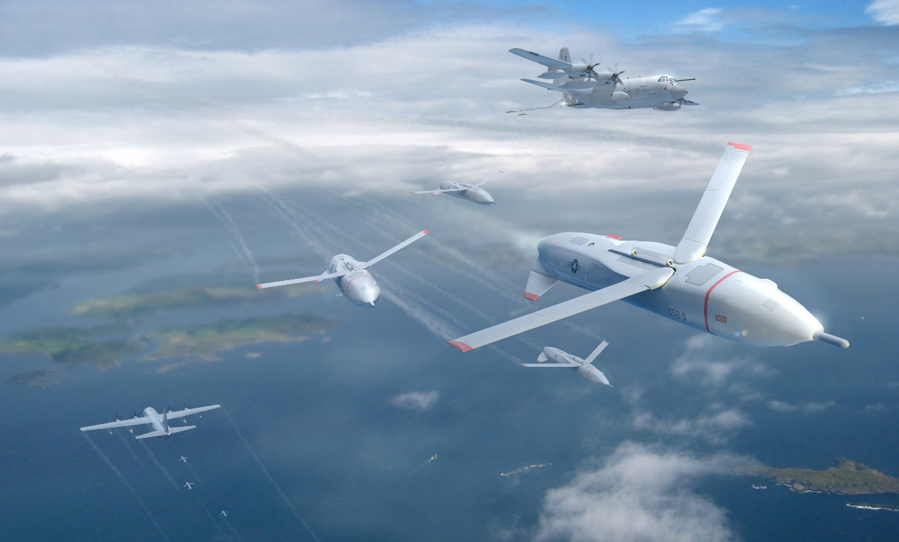Post by torpedo on Jan 23, 2020 0:54:37 GMT
Gremlin Drone's First Flight Turns C-130 Into a Flying Aircraft Carrier
It's a tactic as old as airships.

It's a tactic as old as airships.

By Kyle Mizokami
The X-61A drone program passed a key test with first flight of a Gremlin reusable drone.
Gremlins are multi-use systems, capable of being fitted with different payloads to accomplish different missions.
The drones are designed to be launched and recovered from larger aircraft, a tactic first explored during the age of airships.
The Pentagon’s leading research and development agency conducted the first flight of the X-61A drone system. Known as the Gremlin, the X-61A would be launched by large aircraft near the battlefield, fly a pre-assigned mission, and then be recovered in midair without the need to land. The Gremlin will in effect turn larger aircraft into flying aircraft carriers.
Advertisement - Continue Reading Below
The test took place at the U.S. Army’s Dugway Proving Ground in Utah. A X-61A drone was released from a wing-mounted pylon on a C-130A Hercules transport aircraft. The drone flew for 1 hour, 41 minutes before crashing. According to the Defense Advanced Research Projects Agency (DARPA), a “parachute anomaly occurred” during recovery that “resulted in the loss of the test vehicle.”
Here’s video from the test:
Gremlins are multi-use systems, capable of being fitted with different payloads to accomplish different missions.
The drones are designed to be launched and recovered from larger aircraft, a tactic first explored during the age of airships.
The Pentagon’s leading research and development agency conducted the first flight of the X-61A drone system. Known as the Gremlin, the X-61A would be launched by large aircraft near the battlefield, fly a pre-assigned mission, and then be recovered in midair without the need to land. The Gremlin will in effect turn larger aircraft into flying aircraft carriers.
Advertisement - Continue Reading Below
The test took place at the U.S. Army’s Dugway Proving Ground in Utah. A X-61A drone was released from a wing-mounted pylon on a C-130A Hercules transport aircraft. The drone flew for 1 hour, 41 minutes before crashing. According to the Defense Advanced Research Projects Agency (DARPA), a “parachute anomaly occurred” during recovery that “resulted in the loss of the test vehicle.”
Here’s video from the test:
"The vehicle performed well, giving us confidence we are on the right path and can expect success in our follow-on efforts," said Scott Wierzbanowski, Gremlins project manager. "We got a closer look at vehicle performance for launch, rate capture, engine start, and transition to free flight. We had simulated the performance on the ground, and have now fully tested them in the air. We also demonstrated a variety of vehicle maneuvers that helped validate our aerodynamic data."
The X-61 Gremlins are named after mythical creatures that Allied aircrews blamed for minor issues with their aircraft during World War II. The X-61A will eventually be launched from a C-130J Super Hercules transport. Possible missions include electronic warfare jamming, searching for enemy air defense radars and missile launchers, performing surveillance on a moving target, or even battle damage assessment after an air or missile strike.
Gremlins could also be used as a low-cost cruise missile. Gremlins could be equipped with a high-explosive warhead and loiter over the battlefield, waiting to be assigned a target. Once assigned, it would perform a suicide mission, diving into the target and delivering its warhead payload. A single swarm of Gremlins might fly to the suspected location of an enemy surface-to-air missile site, cooperatively locating, bombing, and recording evidence of the target’s destruction—all without involving manned aircraft.
After the mission is complete the X-61A is reeled back aboard their launch aircraft using an in-flight recovery system. Gremlins are designed to be reusable with recovered drones ready for action within 24 hours. The drones will have a lifespan of about 20 missions, making them cheap enough to buy in large numbers. Each Gremlin can carry a payload of up to 150 pounds.
The loss of the X-61A brings the number of test Gremlins down to four. The final test flight in the X-61A program, according to FlightGlobal, will involve a manned aircraft recovering all four remaining Gremlins in midair.
The loss of the X-61A brings the number of test Gremlins down to four. The final test flight in the X-61A program, according to FlightGlobal, will involve a manned aircraft recovering all four remaining Gremlins in midair.











